PUBH6000 Report: Social Determinants Impacting Indigenous Heart Health
VerifiedAdded on 2022/08/20
|8
|2171
|16
Report
AI Summary
This report, prepared for PUBH6000, delves into the critical issue of heart disease among the Indigenous population of Australia, highlighting the significant burden and prevalence of the condition. It meticulously examines the social determinants of health, such as socioeconomic challenges, discrimination, lack of education, unemployment, poverty, and inadequate access to healthcare, as key factors contributing to health disparities. The report emphasizes how these determinants lead to increased behavioral risk factors, including tobacco use and unhealthy lifestyles, ultimately increasing the risk of heart disease. Furthermore, it proposes a public health intervention, advocating for the development of healthcare facilities in rural areas, health education programs, and skill-development initiatives to address the social and environmental factors affecting the Indigenous community. The intervention aims to improve the quality of life, reduce mental stress, and promote healthy behaviors, ultimately leading to a decrease in heart disease among this population.
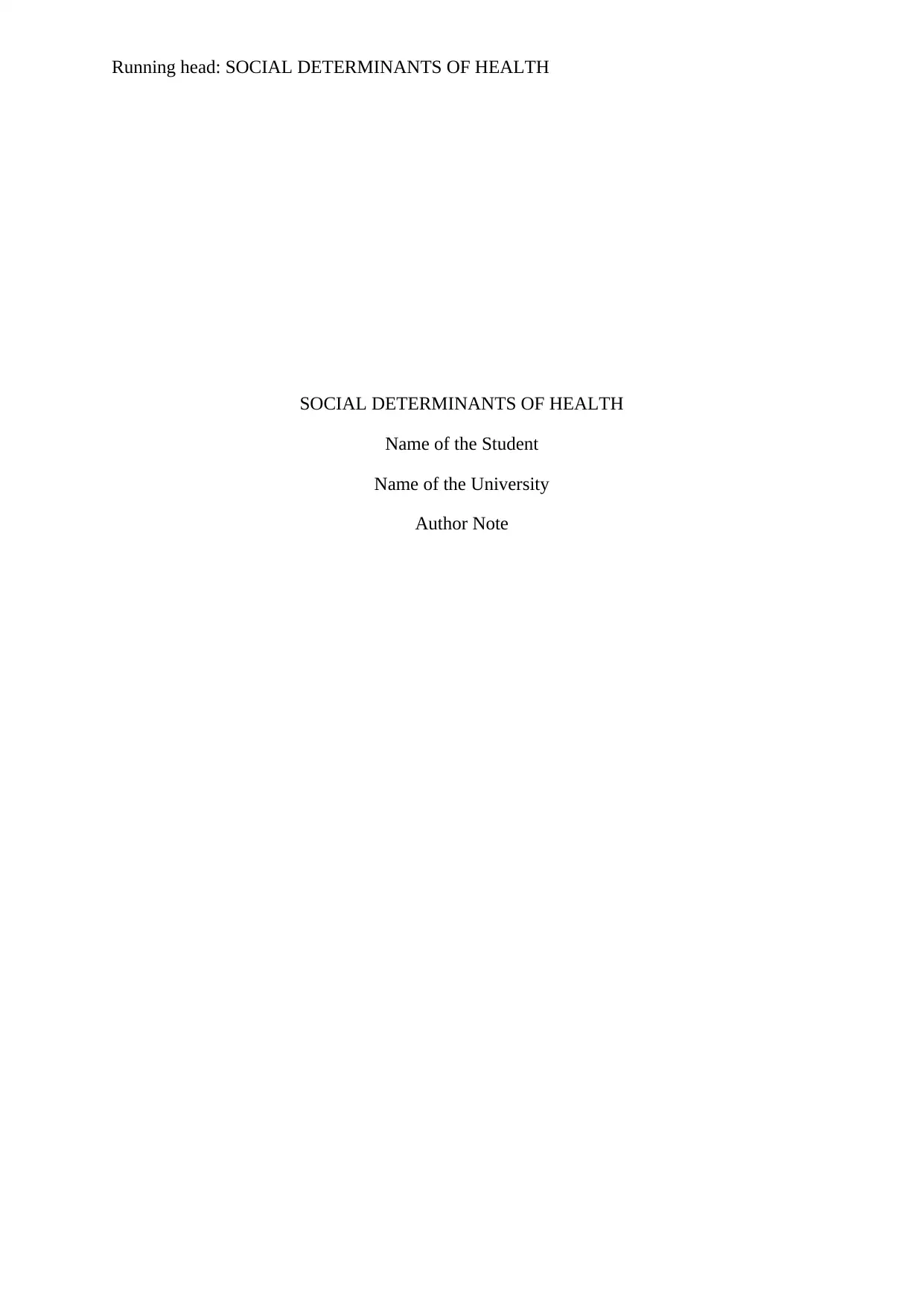
Running head: SOCIAL DETERMINANTS OF HEALTH
SOCIAL DETERMINANTS OF HEALTH
Name of the Student
Name of the University
Author Note
SOCIAL DETERMINANTS OF HEALTH
Name of the Student
Name of the University
Author Note
Paraphrase This Document
Need a fresh take? Get an instant paraphrase of this document with our AI Paraphraser
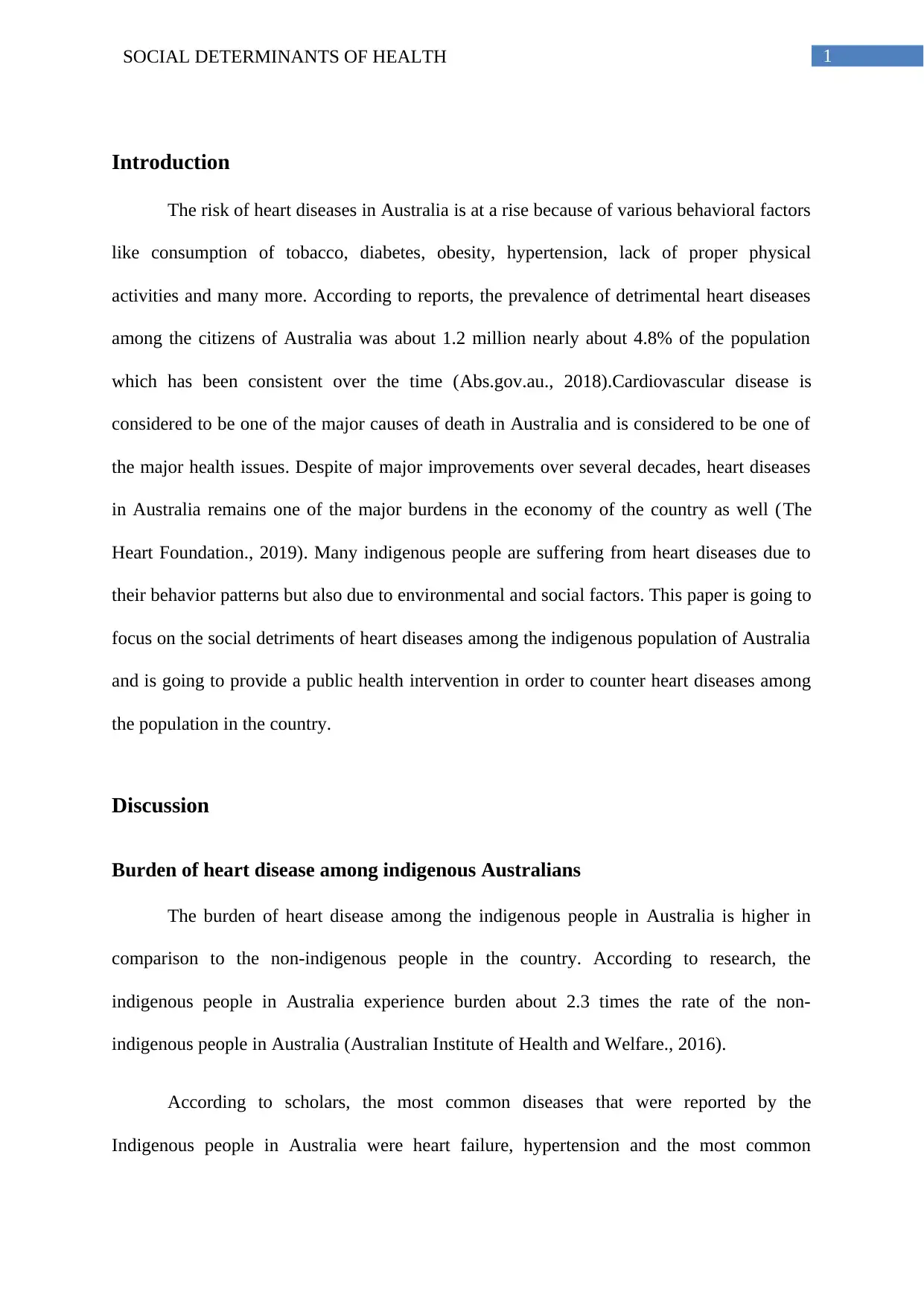
1SOCIAL DETERMINANTS OF HEALTH
Introduction
The risk of heart diseases in Australia is at a rise because of various behavioral factors
like consumption of tobacco, diabetes, obesity, hypertension, lack of proper physical
activities and many more. According to reports, the prevalence of detrimental heart diseases
among the citizens of Australia was about 1.2 million nearly about 4.8% of the population
which has been consistent over the time (Abs.gov.au., 2018).Cardiovascular disease is
considered to be one of the major causes of death in Australia and is considered to be one of
the major health issues. Despite of major improvements over several decades, heart diseases
in Australia remains one of the major burdens in the economy of the country as well (The
Heart Foundation., 2019). Many indigenous people are suffering from heart diseases due to
their behavior patterns but also due to environmental and social factors. This paper is going to
focus on the social detriments of heart diseases among the indigenous population of Australia
and is going to provide a public health intervention in order to counter heart diseases among
the population in the country.
Discussion
Burden of heart disease among indigenous Australians
The burden of heart disease among the indigenous people in Australia is higher in
comparison to the non-indigenous people in the country. According to research, the
indigenous people in Australia experience burden about 2.3 times the rate of the non-
indigenous people in Australia (Australian Institute of Health and Welfare., 2016).
According to scholars, the most common diseases that were reported by the
Indigenous people in Australia were heart failure, hypertension and the most common
Introduction
The risk of heart diseases in Australia is at a rise because of various behavioral factors
like consumption of tobacco, diabetes, obesity, hypertension, lack of proper physical
activities and many more. According to reports, the prevalence of detrimental heart diseases
among the citizens of Australia was about 1.2 million nearly about 4.8% of the population
which has been consistent over the time (Abs.gov.au., 2018).Cardiovascular disease is
considered to be one of the major causes of death in Australia and is considered to be one of
the major health issues. Despite of major improvements over several decades, heart diseases
in Australia remains one of the major burdens in the economy of the country as well (The
Heart Foundation., 2019). Many indigenous people are suffering from heart diseases due to
their behavior patterns but also due to environmental and social factors. This paper is going to
focus on the social detriments of heart diseases among the indigenous population of Australia
and is going to provide a public health intervention in order to counter heart diseases among
the population in the country.
Discussion
Burden of heart disease among indigenous Australians
The burden of heart disease among the indigenous people in Australia is higher in
comparison to the non-indigenous people in the country. According to research, the
indigenous people in Australia experience burden about 2.3 times the rate of the non-
indigenous people in Australia (Australian Institute of Health and Welfare., 2016).
According to scholars, the most common diseases that were reported by the
Indigenous people in Australia were heart failure, hypertension and the most common
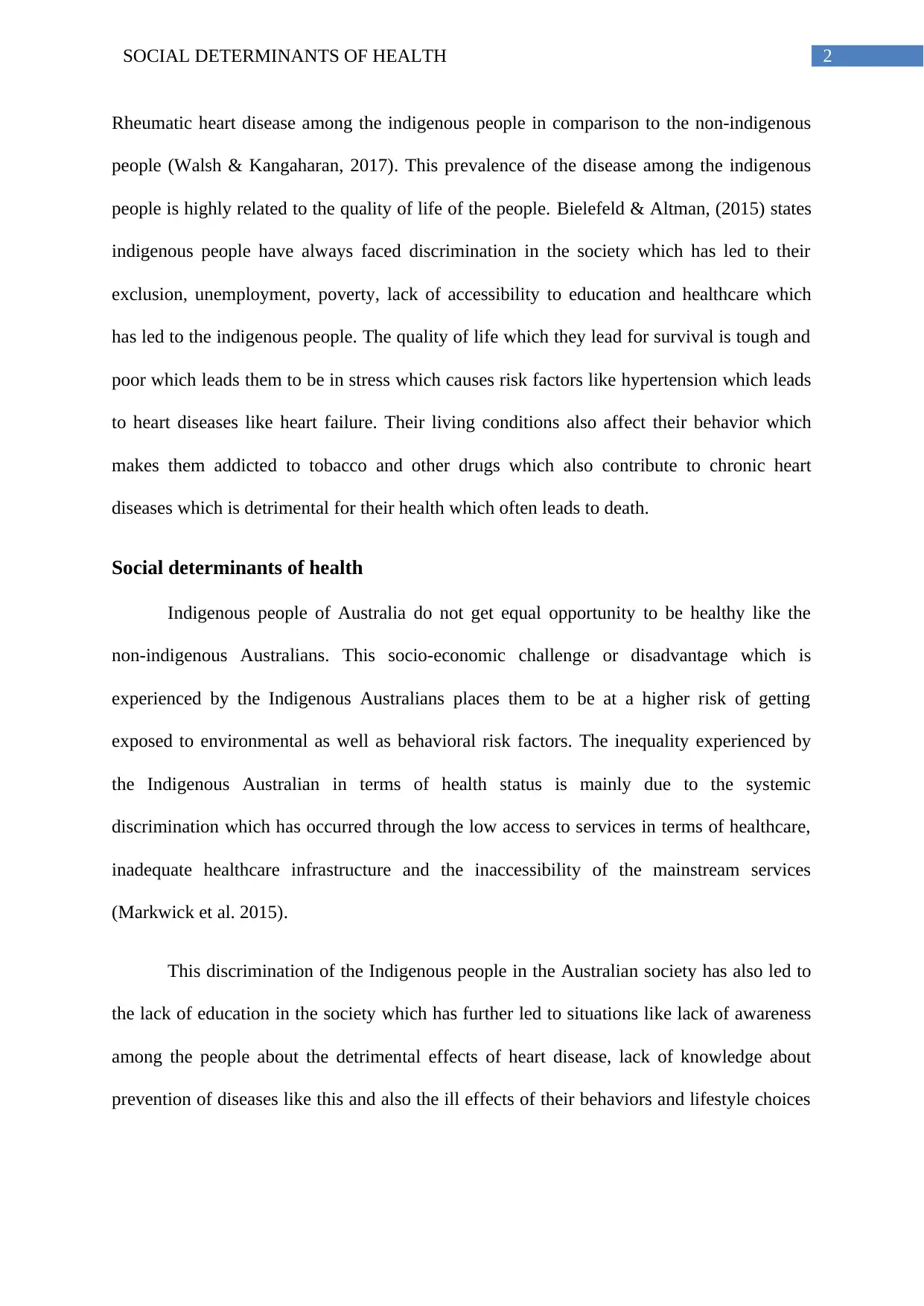
2SOCIAL DETERMINANTS OF HEALTH
Rheumatic heart disease among the indigenous people in comparison to the non-indigenous
people (Walsh & Kangaharan, 2017). This prevalence of the disease among the indigenous
people is highly related to the quality of life of the people. Bielefeld & Altman, (2015) states
indigenous people have always faced discrimination in the society which has led to their
exclusion, unemployment, poverty, lack of accessibility to education and healthcare which
has led to the indigenous people. The quality of life which they lead for survival is tough and
poor which leads them to be in stress which causes risk factors like hypertension which leads
to heart diseases like heart failure. Their living conditions also affect their behavior which
makes them addicted to tobacco and other drugs which also contribute to chronic heart
diseases which is detrimental for their health which often leads to death.
Social determinants of health
Indigenous people of Australia do not get equal opportunity to be healthy like the
non-indigenous Australians. This socio-economic challenge or disadvantage which is
experienced by the Indigenous Australians places them to be at a higher risk of getting
exposed to environmental as well as behavioral risk factors. The inequality experienced by
the Indigenous Australian in terms of health status is mainly due to the systemic
discrimination which has occurred through the low access to services in terms of healthcare,
inadequate healthcare infrastructure and the inaccessibility of the mainstream services
(Markwick et al. 2015).
This discrimination of the Indigenous people in the Australian society has also led to
the lack of education in the society which has further led to situations like lack of awareness
among the people about the detrimental effects of heart disease, lack of knowledge about
prevention of diseases like this and also the ill effects of their behaviors and lifestyle choices
Rheumatic heart disease among the indigenous people in comparison to the non-indigenous
people (Walsh & Kangaharan, 2017). This prevalence of the disease among the indigenous
people is highly related to the quality of life of the people. Bielefeld & Altman, (2015) states
indigenous people have always faced discrimination in the society which has led to their
exclusion, unemployment, poverty, lack of accessibility to education and healthcare which
has led to the indigenous people. The quality of life which they lead for survival is tough and
poor which leads them to be in stress which causes risk factors like hypertension which leads
to heart diseases like heart failure. Their living conditions also affect their behavior which
makes them addicted to tobacco and other drugs which also contribute to chronic heart
diseases which is detrimental for their health which often leads to death.
Social determinants of health
Indigenous people of Australia do not get equal opportunity to be healthy like the
non-indigenous Australians. This socio-economic challenge or disadvantage which is
experienced by the Indigenous Australians places them to be at a higher risk of getting
exposed to environmental as well as behavioral risk factors. The inequality experienced by
the Indigenous Australian in terms of health status is mainly due to the systemic
discrimination which has occurred through the low access to services in terms of healthcare,
inadequate healthcare infrastructure and the inaccessibility of the mainstream services
(Markwick et al. 2015).
This discrimination of the Indigenous people in the Australian society has also led to
the lack of education in the society which has further led to situations like lack of awareness
among the people about the detrimental effects of heart disease, lack of knowledge about
prevention of diseases like this and also the ill effects of their behaviors and lifestyle choices
⊘ This is a preview!⊘
Do you want full access?
Subscribe today to unlock all pages.

Trusted by 1+ million students worldwide
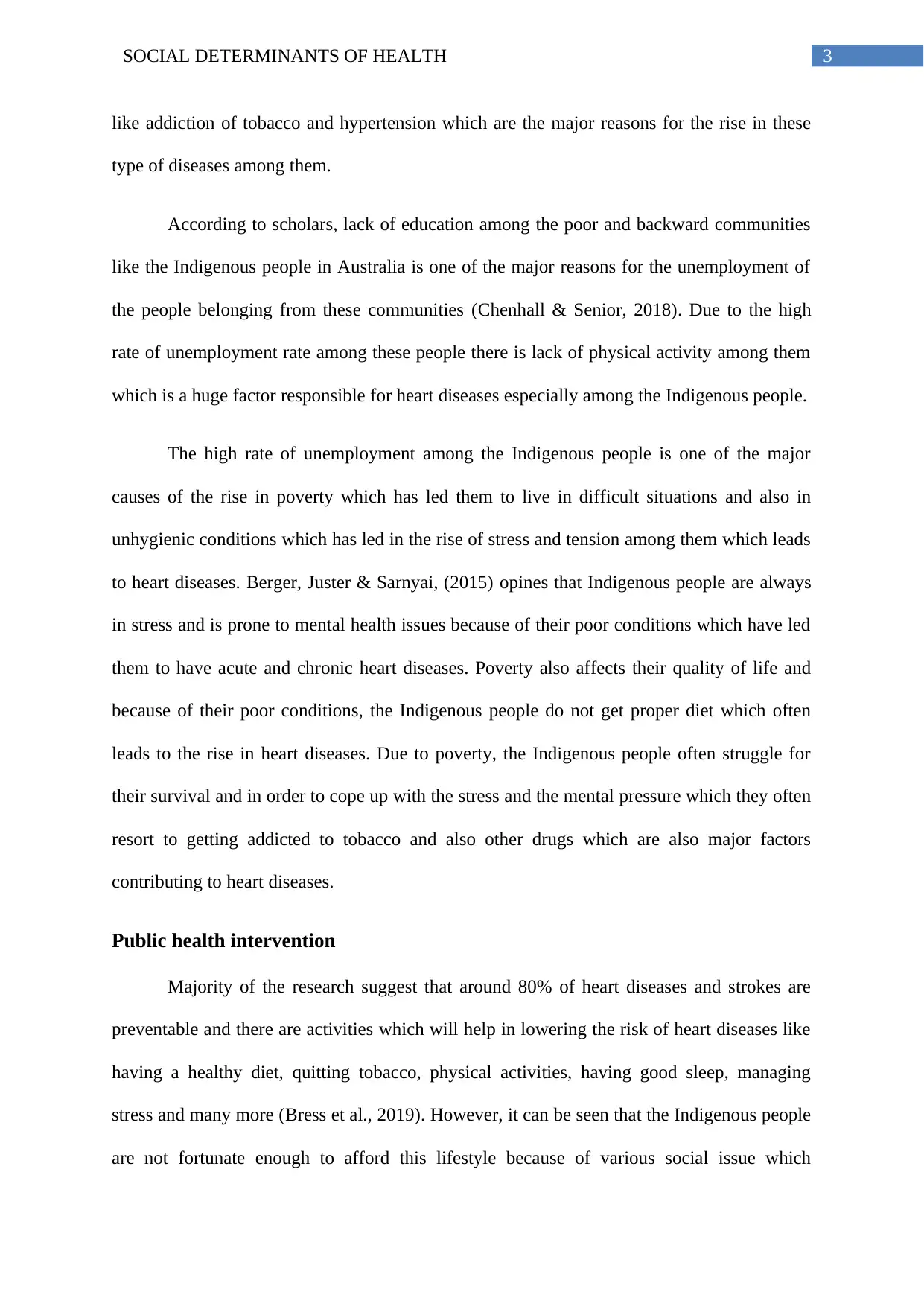
3SOCIAL DETERMINANTS OF HEALTH
like addiction of tobacco and hypertension which are the major reasons for the rise in these
type of diseases among them.
According to scholars, lack of education among the poor and backward communities
like the Indigenous people in Australia is one of the major reasons for the unemployment of
the people belonging from these communities (Chenhall & Senior, 2018). Due to the high
rate of unemployment rate among these people there is lack of physical activity among them
which is a huge factor responsible for heart diseases especially among the Indigenous people.
The high rate of unemployment among the Indigenous people is one of the major
causes of the rise in poverty which has led them to live in difficult situations and also in
unhygienic conditions which has led in the rise of stress and tension among them which leads
to heart diseases. Berger, Juster & Sarnyai, (2015) opines that Indigenous people are always
in stress and is prone to mental health issues because of their poor conditions which have led
them to have acute and chronic heart diseases. Poverty also affects their quality of life and
because of their poor conditions, the Indigenous people do not get proper diet which often
leads to the rise in heart diseases. Due to poverty, the Indigenous people often struggle for
their survival and in order to cope up with the stress and the mental pressure which they often
resort to getting addicted to tobacco and also other drugs which are also major factors
contributing to heart diseases.
Public health intervention
Majority of the research suggest that around 80% of heart diseases and strokes are
preventable and there are activities which will help in lowering the risk of heart diseases like
having a healthy diet, quitting tobacco, physical activities, having good sleep, managing
stress and many more (Bress et al., 2019). However, it can be seen that the Indigenous people
are not fortunate enough to afford this lifestyle because of various social issue which
like addiction of tobacco and hypertension which are the major reasons for the rise in these
type of diseases among them.
According to scholars, lack of education among the poor and backward communities
like the Indigenous people in Australia is one of the major reasons for the unemployment of
the people belonging from these communities (Chenhall & Senior, 2018). Due to the high
rate of unemployment rate among these people there is lack of physical activity among them
which is a huge factor responsible for heart diseases especially among the Indigenous people.
The high rate of unemployment among the Indigenous people is one of the major
causes of the rise in poverty which has led them to live in difficult situations and also in
unhygienic conditions which has led in the rise of stress and tension among them which leads
to heart diseases. Berger, Juster & Sarnyai, (2015) opines that Indigenous people are always
in stress and is prone to mental health issues because of their poor conditions which have led
them to have acute and chronic heart diseases. Poverty also affects their quality of life and
because of their poor conditions, the Indigenous people do not get proper diet which often
leads to the rise in heart diseases. Due to poverty, the Indigenous people often struggle for
their survival and in order to cope up with the stress and the mental pressure which they often
resort to getting addicted to tobacco and also other drugs which are also major factors
contributing to heart diseases.
Public health intervention
Majority of the research suggest that around 80% of heart diseases and strokes are
preventable and there are activities which will help in lowering the risk of heart diseases like
having a healthy diet, quitting tobacco, physical activities, having good sleep, managing
stress and many more (Bress et al., 2019). However, it can be seen that the Indigenous people
are not fortunate enough to afford this lifestyle because of various social issue which
Paraphrase This Document
Need a fresh take? Get an instant paraphrase of this document with our AI Paraphraser

4SOCIAL DETERMINANTS OF HEALTH
contribute to their poor lifestyle which lead to them suffering from several diseases, heart
diseases being one of the most common one. It can be seen that the causes of heart disease
among the Indigenous are linked with several social and environmental factors and thus all
the factors need to be focused and eradicated in order to enhance the quality of life. Due to a
huge number of populations suffering from heart diseases a public health intervention is
required to tackle this issue to provide quality life to the Indigenous people in Australia.
One of the key factors that has contributed to the growth of heart diseases among the
Indigenous people is the lack of medical facilities and infrastructure in rural areas where this
population can mainly be located. According to scholars, many Indigenous people have lost
their lives because of inaccessibility of effective and efficient healthcare (Fast & Collin-
Vézina, 2019). Thus, the government should take initiatives to develop healthcare facilities
and hospitals in rural areas and make healthcare affordable for these people so that they can
avail the services when there is an emergency or even in general. The Indigenous people are a
part of Australia and thus it is the responsibility of the government to intervene in this matter
to help saving the lives of people who are in distress.
The government in collaboration with NGO’s should come with initiatives and
programs in order to educate the Indigenous people in the rural areas and also come up with
health programs in order to spread awareness about the risk factors of heart diseases. It has
been seen that this section of the population suffer from various diseases that can later lead
to heart diseases but due to the lack of knowledge it has been seen that they fail to visit
healthcare centers related nearby. Thus, it is important to educate people and make them
aware of the causes and the prevention of heart disease. Altman, (2018) states education is
one of the solutions to mitigate the issue of poverty. Thus, this will also help in Indigenous
people being employed which will help in reducing the poverty rate that will help in
contribute to their poor lifestyle which lead to them suffering from several diseases, heart
diseases being one of the most common one. It can be seen that the causes of heart disease
among the Indigenous are linked with several social and environmental factors and thus all
the factors need to be focused and eradicated in order to enhance the quality of life. Due to a
huge number of populations suffering from heart diseases a public health intervention is
required to tackle this issue to provide quality life to the Indigenous people in Australia.
One of the key factors that has contributed to the growth of heart diseases among the
Indigenous people is the lack of medical facilities and infrastructure in rural areas where this
population can mainly be located. According to scholars, many Indigenous people have lost
their lives because of inaccessibility of effective and efficient healthcare (Fast & Collin-
Vézina, 2019). Thus, the government should take initiatives to develop healthcare facilities
and hospitals in rural areas and make healthcare affordable for these people so that they can
avail the services when there is an emergency or even in general. The Indigenous people are a
part of Australia and thus it is the responsibility of the government to intervene in this matter
to help saving the lives of people who are in distress.
The government in collaboration with NGO’s should come with initiatives and
programs in order to educate the Indigenous people in the rural areas and also come up with
health programs in order to spread awareness about the risk factors of heart diseases. It has
been seen that this section of the population suffer from various diseases that can later lead
to heart diseases but due to the lack of knowledge it has been seen that they fail to visit
healthcare centers related nearby. Thus, it is important to educate people and make them
aware of the causes and the prevention of heart disease. Altman, (2018) states education is
one of the solutions to mitigate the issue of poverty. Thus, this will also help in Indigenous
people being employed which will help in reducing the poverty rate that will help in

5SOCIAL DETERMINANTS OF HEALTH
enhancing the quality of life. Better quality of life will help the people to recover from issues
like mental stress and help in getting a proper diet which is essential to prevent heart diseases.
The government alongside the NGO’s should come up with initiative programs that
will help Indigenous people develop skills which can also help them in doing a physical
activity which can help in reducing the risk of getting a heart disease and at the same time
will help in providing employment opportunities to the people which will alongside help in
eradicating or curbing the issue of rise in unemployment and poverty.
The government needs to come up with policies that ensure the overall welfare of the
Indigenous community in Australia like free health check-ups and free medicines, education
for all children, check the environment of the rural areas and also provide food to them at
cheaper rates which will help in enhancing their quality of life which can reduce mental stress
and hypertension which will help in reducing the risk of heart diseases among these people.
Conclusion
The Indigenous people in Australia have been prone to heart diseases because of their
poor lifestyle and discrimination in the society. Other than their behavioral patterns there are
many other social determinants of the health which has contributed to the rise in health risk of
the community in terms of heart risks. Thus, in order to ensure the Indigenous people prevent
this serious illness, it is important for the government to intervene in the matter and take
measurable steps like promoting health awareness, educating them, setting up health facilities
and many more in order to reduce the rate of heart diseases among the Indigenous Australians
and ensure they lead a good quality and a healthy life which is their basic human right.
enhancing the quality of life. Better quality of life will help the people to recover from issues
like mental stress and help in getting a proper diet which is essential to prevent heart diseases.
The government alongside the NGO’s should come up with initiative programs that
will help Indigenous people develop skills which can also help them in doing a physical
activity which can help in reducing the risk of getting a heart disease and at the same time
will help in providing employment opportunities to the people which will alongside help in
eradicating or curbing the issue of rise in unemployment and poverty.
The government needs to come up with policies that ensure the overall welfare of the
Indigenous community in Australia like free health check-ups and free medicines, education
for all children, check the environment of the rural areas and also provide food to them at
cheaper rates which will help in enhancing their quality of life which can reduce mental stress
and hypertension which will help in reducing the risk of heart diseases among these people.
Conclusion
The Indigenous people in Australia have been prone to heart diseases because of their
poor lifestyle and discrimination in the society. Other than their behavioral patterns there are
many other social determinants of the health which has contributed to the rise in health risk of
the community in terms of heart risks. Thus, in order to ensure the Indigenous people prevent
this serious illness, it is important for the government to intervene in the matter and take
measurable steps like promoting health awareness, educating them, setting up health facilities
and many more in order to reduce the rate of heart diseases among the Indigenous Australians
and ensure they lead a good quality and a healthy life which is their basic human right.
⊘ This is a preview!⊘
Do you want full access?
Subscribe today to unlock all pages.

Trusted by 1+ million students worldwide
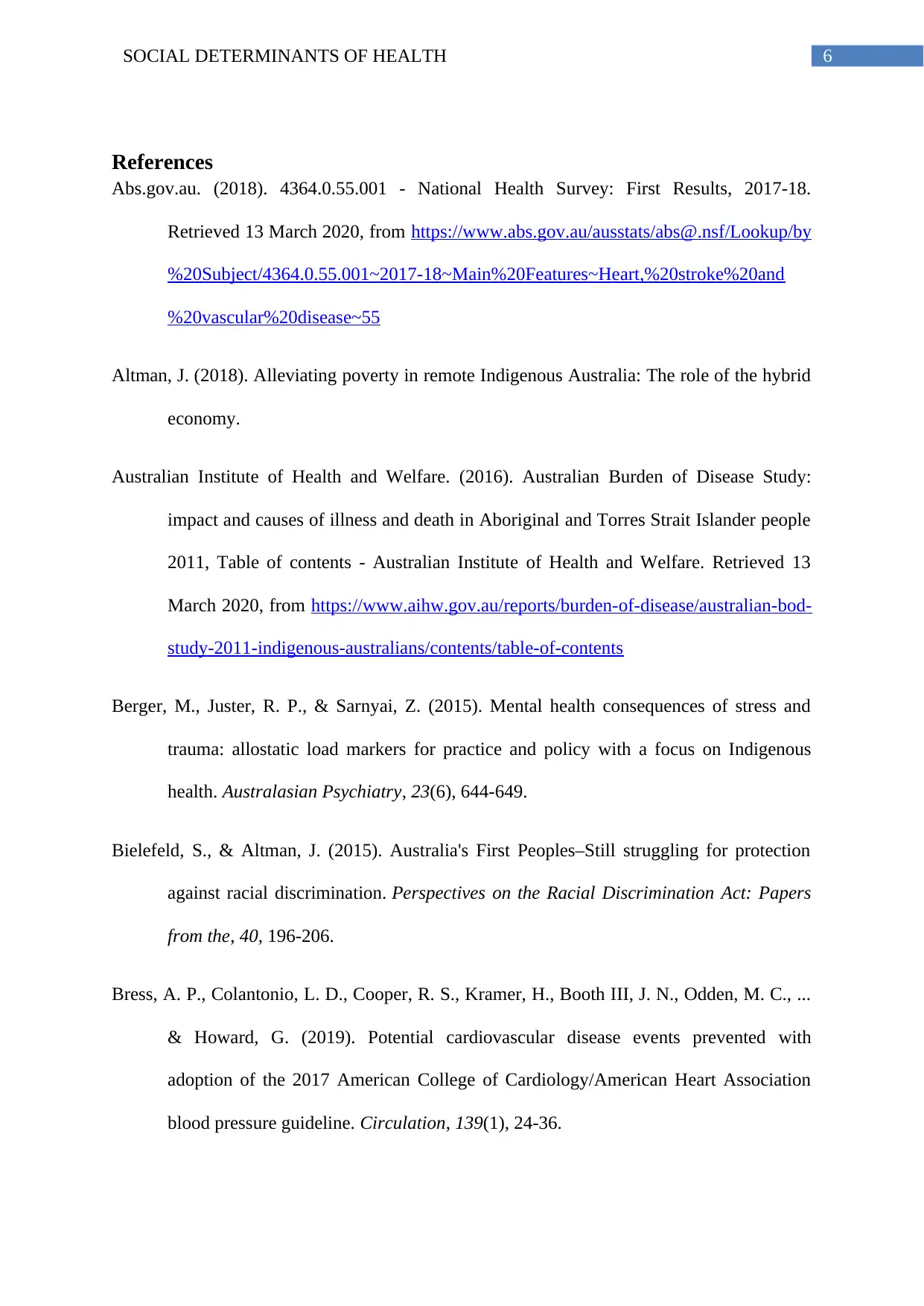
6SOCIAL DETERMINANTS OF HEALTH
References
Abs.gov.au. (2018). 4364.0.55.001 - National Health Survey: First Results, 2017-18.
Retrieved 13 March 2020, from https://www.abs.gov.au/ausstats/abs@.nsf/Lookup/by
%20Subject/4364.0.55.001~2017-18~Main%20Features~Heart,%20stroke%20and
%20vascular%20disease~55
Altman, J. (2018). Alleviating poverty in remote Indigenous Australia: The role of the hybrid
economy.
Australian Institute of Health and Welfare. (2016). Australian Burden of Disease Study:
impact and causes of illness and death in Aboriginal and Torres Strait Islander people
2011, Table of contents - Australian Institute of Health and Welfare. Retrieved 13
March 2020, from https://www.aihw.gov.au/reports/burden-of-disease/australian-bod-
study-2011-indigenous-australians/contents/table-of-contents
Berger, M., Juster, R. P., & Sarnyai, Z. (2015). Mental health consequences of stress and
trauma: allostatic load markers for practice and policy with a focus on Indigenous
health. Australasian Psychiatry, 23(6), 644-649.
Bielefeld, S., & Altman, J. (2015). Australia's First Peoples–Still struggling for protection
against racial discrimination. Perspectives on the Racial Discrimination Act: Papers
from the, 40, 196-206.
Bress, A. P., Colantonio, L. D., Cooper, R. S., Kramer, H., Booth III, J. N., Odden, M. C., ...
& Howard, G. (2019). Potential cardiovascular disease events prevented with
adoption of the 2017 American College of Cardiology/American Heart Association
blood pressure guideline. Circulation, 139(1), 24-36.
References
Abs.gov.au. (2018). 4364.0.55.001 - National Health Survey: First Results, 2017-18.
Retrieved 13 March 2020, from https://www.abs.gov.au/ausstats/abs@.nsf/Lookup/by
%20Subject/4364.0.55.001~2017-18~Main%20Features~Heart,%20stroke%20and
%20vascular%20disease~55
Altman, J. (2018). Alleviating poverty in remote Indigenous Australia: The role of the hybrid
economy.
Australian Institute of Health and Welfare. (2016). Australian Burden of Disease Study:
impact and causes of illness and death in Aboriginal and Torres Strait Islander people
2011, Table of contents - Australian Institute of Health and Welfare. Retrieved 13
March 2020, from https://www.aihw.gov.au/reports/burden-of-disease/australian-bod-
study-2011-indigenous-australians/contents/table-of-contents
Berger, M., Juster, R. P., & Sarnyai, Z. (2015). Mental health consequences of stress and
trauma: allostatic load markers for practice and policy with a focus on Indigenous
health. Australasian Psychiatry, 23(6), 644-649.
Bielefeld, S., & Altman, J. (2015). Australia's First Peoples–Still struggling for protection
against racial discrimination. Perspectives on the Racial Discrimination Act: Papers
from the, 40, 196-206.
Bress, A. P., Colantonio, L. D., Cooper, R. S., Kramer, H., Booth III, J. N., Odden, M. C., ...
& Howard, G. (2019). Potential cardiovascular disease events prevented with
adoption of the 2017 American College of Cardiology/American Heart Association
blood pressure guideline. Circulation, 139(1), 24-36.
Paraphrase This Document
Need a fresh take? Get an instant paraphrase of this document with our AI Paraphraser
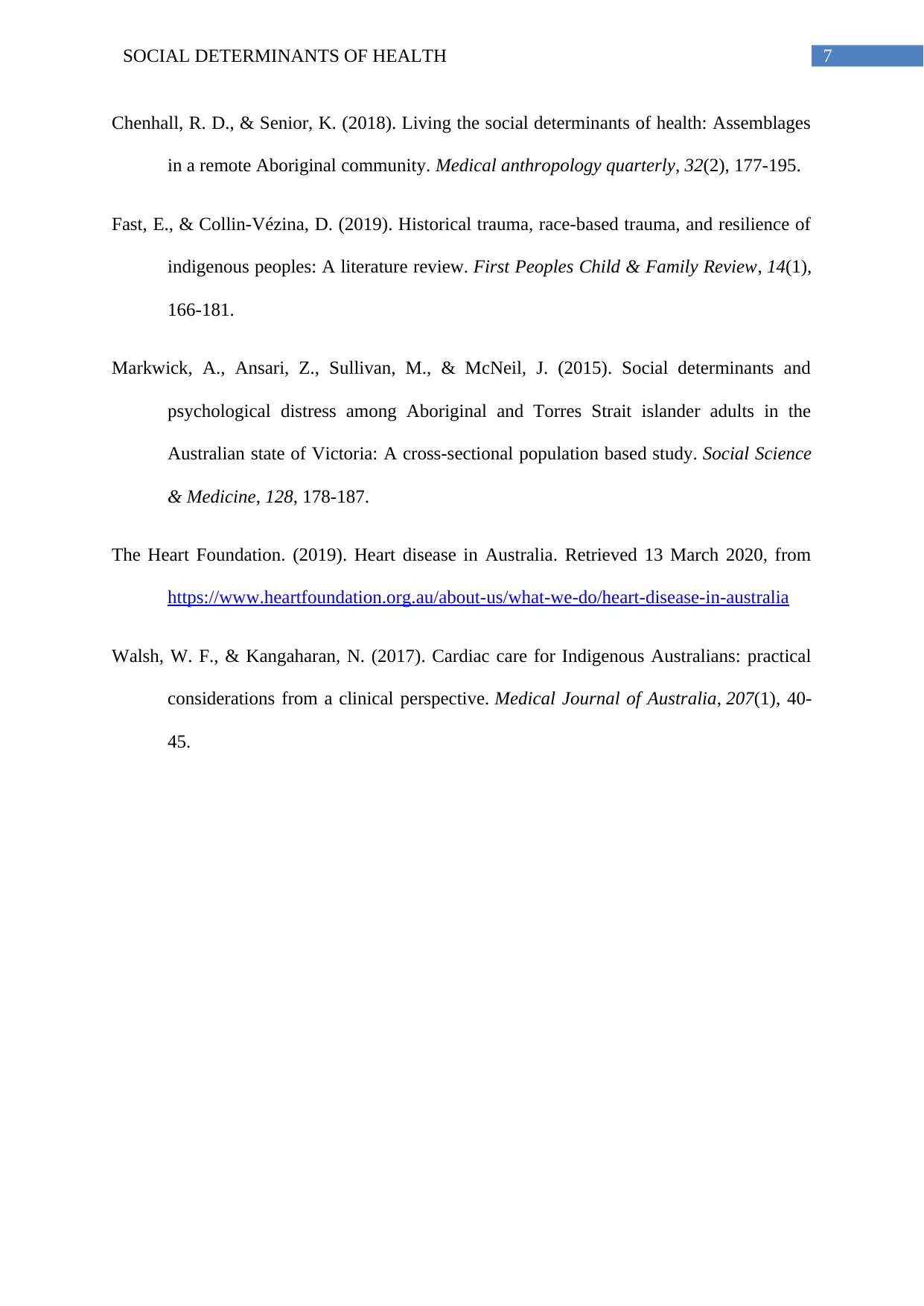
7SOCIAL DETERMINANTS OF HEALTH
Chenhall, R. D., & Senior, K. (2018). Living the social determinants of health: Assemblages
in a remote Aboriginal community. Medical anthropology quarterly, 32(2), 177-195.
Fast, E., & Collin-Vézina, D. (2019). Historical trauma, race-based trauma, and resilience of
indigenous peoples: A literature review. First Peoples Child & Family Review, 14(1),
166-181.
Markwick, A., Ansari, Z., Sullivan, M., & McNeil, J. (2015). Social determinants and
psychological distress among Aboriginal and Torres Strait islander adults in the
Australian state of Victoria: A cross-sectional population based study. Social Science
& Medicine, 128, 178-187.
The Heart Foundation. (2019). Heart disease in Australia. Retrieved 13 March 2020, from
https://www.heartfoundation.org.au/about-us/what-we-do/heart-disease-in-australia
Walsh, W. F., & Kangaharan, N. (2017). Cardiac care for Indigenous Australians: practical
considerations from a clinical perspective. Medical Journal of Australia, 207(1), 40-
45.
Chenhall, R. D., & Senior, K. (2018). Living the social determinants of health: Assemblages
in a remote Aboriginal community. Medical anthropology quarterly, 32(2), 177-195.
Fast, E., & Collin-Vézina, D. (2019). Historical trauma, race-based trauma, and resilience of
indigenous peoples: A literature review. First Peoples Child & Family Review, 14(1),
166-181.
Markwick, A., Ansari, Z., Sullivan, M., & McNeil, J. (2015). Social determinants and
psychological distress among Aboriginal and Torres Strait islander adults in the
Australian state of Victoria: A cross-sectional population based study. Social Science
& Medicine, 128, 178-187.
The Heart Foundation. (2019). Heart disease in Australia. Retrieved 13 March 2020, from
https://www.heartfoundation.org.au/about-us/what-we-do/heart-disease-in-australia
Walsh, W. F., & Kangaharan, N. (2017). Cardiac care for Indigenous Australians: practical
considerations from a clinical perspective. Medical Journal of Australia, 207(1), 40-
45.
1 out of 8
Related Documents
Your All-in-One AI-Powered Toolkit for Academic Success.
+13062052269
info@desklib.com
Available 24*7 on WhatsApp / Email
![[object Object]](/_next/static/media/star-bottom.7253800d.svg)
Unlock your academic potential
Copyright © 2020–2025 A2Z Services. All Rights Reserved. Developed and managed by ZUCOL.




